|
USS GERALD FORD
CVN-78
aircraft
carrier model
USS Gerald R. Ford
(CVN-78) is the lead ship of her class of United States
Navy aircraft carriers. Construction began on 11 August
2005. 12 years later, she was commissioned, on 22 July 2017.
CVN-78 is the world's largest warship ever constructed,
costing nearly $13 billion, not including the costs of
aircraft.
Ford design introduced two dozen new technologies into a
vessel that superficially looks similar to the Nimitz
class of carriers it is replacing.

The
most important metric of carrier lethality is how many
sorties the ship can generate each day.
To achieve the Sortie Generation Rate (SGR)
uptick, the Ford relies
upon the Navy’s newest aircraft launch and recovery
technology, namely, the Electromagnetic Aircraft Launch
System (EMALS) and the Advanced Arresting Gear System (AAG).
The EMALS replaces the traditional steam
piston catapult found on the Nimitz carriers. Using a
linear induction motor – which uses electric currents to
generate magnetic fields that propel an aircraft along a
track – the EMALS is expected to accelerate aircraft
more smoothly (thus putting less stress on the
airframes) while costing less, weighing less, and
requiring less maintenance. Plus, the pivot away from
steam-powered pistons will reduce the Ford’s need for
freshwater (and the energy-intensive desalination
process. The EMALS boosts the Ford’s SGR because they
recharges more quickly than steam catapults and they
allow for launches with more precise settings, meaning
the Gerald Ford will be able to launch more kinds of
aircraft, from heavy fighter jets, to lighter unmanned
vehicles.
When aircraft land on the carrier, the new electric motor-based Advanced
Arresting Gear (AAG) system helps provide deceleration.
AAG
is a novel arresting gear, replacing the
conventional hydraulic arresting gears found on the Nimitz with
energy-absorbing water turbines with a large induction
motor to control the arresting forces to stop the
aircraft.
The new catapult and arresting gear will enable carriers
to launch and recover a more diverse array of aircraft,
both lighter and heavier than those hosted on a Nimitz
carrier today. That includes drones for collecting
reconnaissance, delivering weapons, and refueling manned
aircraft.
USS Gerald Ford can carry
up to 90 aircrafts--30 more than Nimitz class. She can
sustain 160 sorties per day for 30-plus days, with a
surge capability of 270 sorties per day. Underneath the
massive steel deck, the ship features 40 refueling
stations and a revised configuration for her weapons
elevators. She could achieve about 30 percent greater
sortie generation rates than her predecessors.
Catapult No. 4 on the Nimitz class cannot launch fully
loaded aircraft because of a deficiency of wing
clearance along the edge of the flight deck. CVN-78 has
no catapult-specific restrictions. USS Gerald Ford can launch at least
two and receive one aircraft at the same time during
full combat operations.
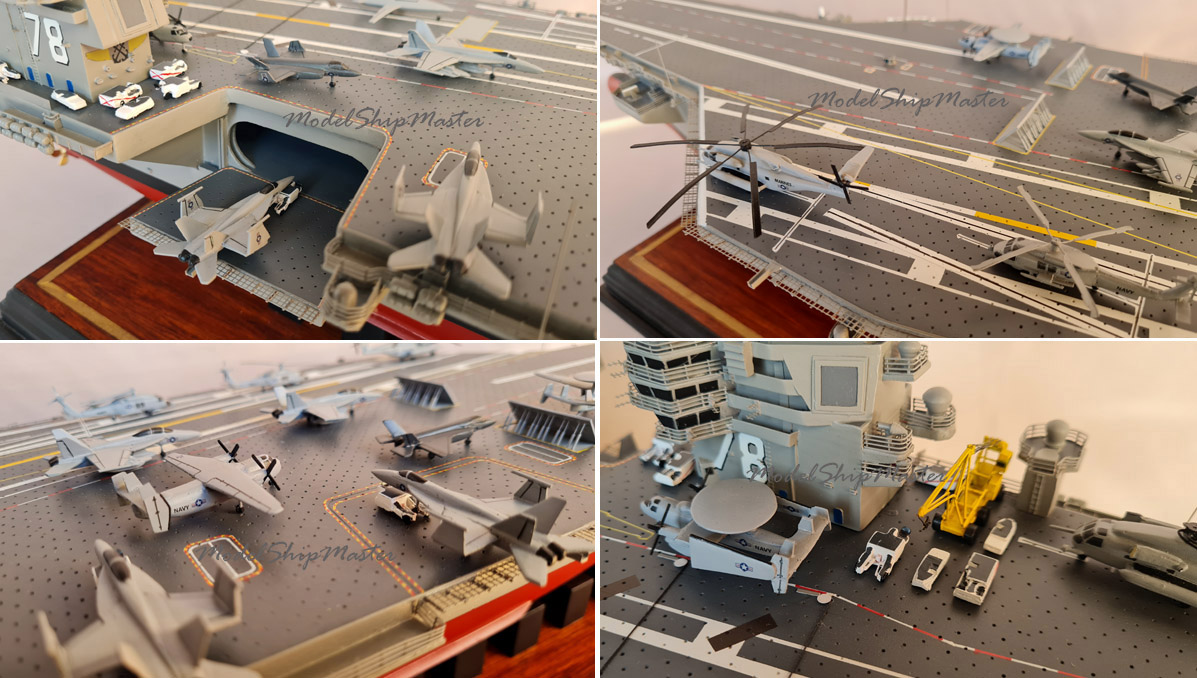
The smaller, redesigned island is further aft than those
of older aircraft carriers. This change creates deck space for a
centralized rearming and refueling location, and thereby
reduces the number of times that an aircraft will have
to be moved after landing before it can be relaunched. Fewer aircraft movements require, in
turn, fewer deck hands to accomplish them, reducing the size of the ship's crew
and increasing sortie rate.
A Nimitz-class
carrier needs a remarkable 5,000 sailors (including
airwing staff) to operate. 1,100
fewer personnel required to operate the USS
Gerald Ford –
a 20 percent reduction from the
Nimitz.
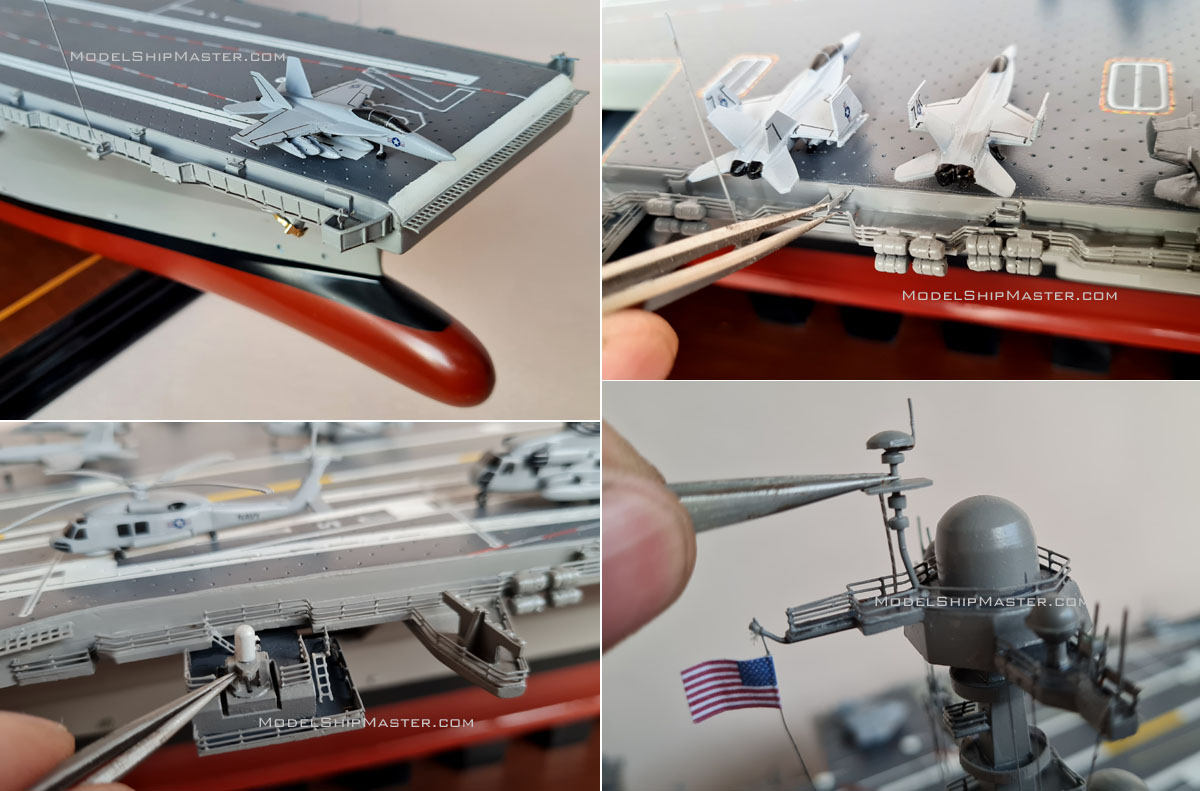

USS Gerald Ford's twin nuclear reactors are almost three
times more powerful than the ones onboard the
Nimitz-class—generating 250 percent more electricity.
The
increased generating capacity is needed to support
futuristic ship defenses like high-power lasers.
CVN-78 has very good air
conditioning in the bridge. This not only makes the crew
more productive but also reduces maintenance
requirements because of lower level of humidity. Ford is
projected to enter drydock only once every 12 years. To
sustain operation, the ship produces 400,000 gallons of fresh
water daily.
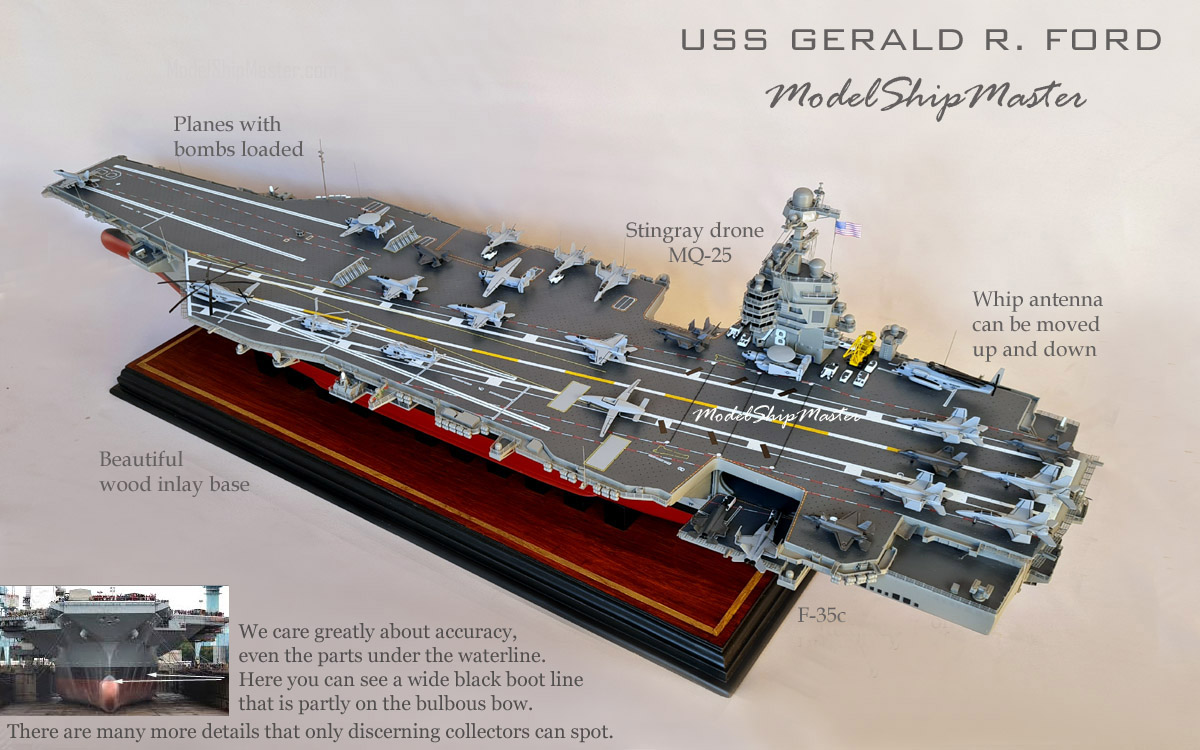
Carrier radars play an essential role in detecting
threats. The Nimitz class requires half a dozen
different radars to accomplish all the necessary
functions, from detection to tracking to target
identification. The USS Gerald Ford's design replaces
this collection of sensors with a single multifunction
radar that takes up much less space. The system is much
more sensitive than previous air-defense radars and easy
to maintain (no moving parts). Because it requires less
space, the island becomes smaller, reducing the
carrier’s own radar signature.
Control systems are far more advanced than anything else
in the Navy’s fleet other than the new
Zumwalt-class destroyers.
All of the controls and navigational systems are
completely digital and use touch-screen interfaces. The
only connection to the past is a metal wheel connected
to an electronic steering. The aircraft carrier has 10
million feet of electric cable and 4 million feet of
fiber optic cable.
Ford-class carrier will cost $4 billion
less to operate across its 50-year lifetime than a
Nimitz-class carrier. That is a great bargain for a
warship that is far superior to what came before in
virtually every performance metric.
The Ford’s cost
overruns and production headaches are undoubtedly the
result of a project so overly ambitious in scope;
incorporating so many novel technologies into one new
platform was quite bold. Yet the first-ever Ford-class
has performed admirably. She promises to be the world’s
most sophisticated warship for several decades.
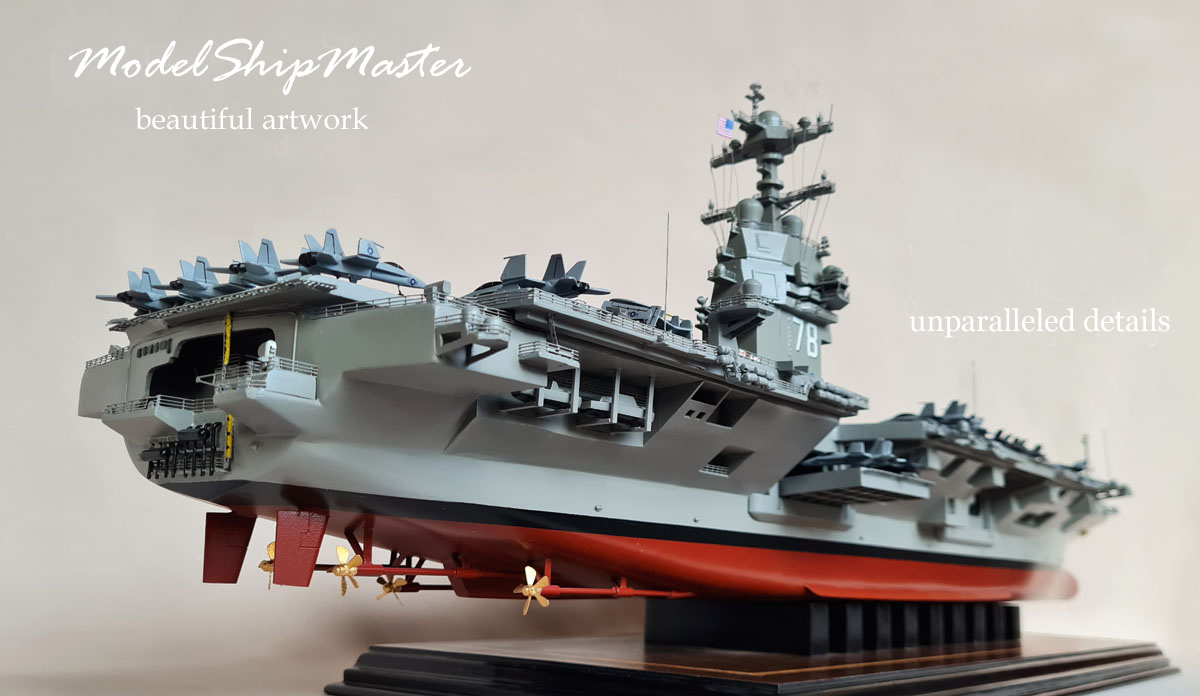
We build this primarily wood model of the USS Gerald
Ford the following sizes:
- 38" long x 12" tall x 10" wide
$4,290
 Shipping and
insurance in the contiguous USA included. Other places:
$400 flat rate. This model is not in stock and it will
take about four to six months when you order it.
Commitment deposit is $900.
Shipping and
insurance in the contiguous USA included. Other places:
$400 flat rate. This model is not in stock and it will
take about four to six months when you order it.
Commitment deposit is $900.
- 29" long:
$3,190
 Shipping and
insurance in the contiguous USA included. Other places:
$300 flat rate. This model is in stock and
can be shipped within five business days.
Shipping and
insurance in the contiguous USA included. Other places:
$300 flat rate. This model is in stock and
can be shipped within five business days.
- 52" long:
Email us for price.
Shipping and insurance in
the contiguous USA included.
Other places: $700 flat rate.
Models are built per
commissions only.
We require only
a small deposit to start the process. The
remaining balance won't be due until the model is
completed. Please click
here
for more details.
|
Our quality and accuracy
tell all. A unit of this model has been purchased by
the military contractor Peerless Instrument
www.curtisswrightds.com/peerless for an engineer of
Bechtel
Plant Machinery. Another is permanently
displayed in
the City of Palm
Coast--sister city of the aircraft carrier. |

 |
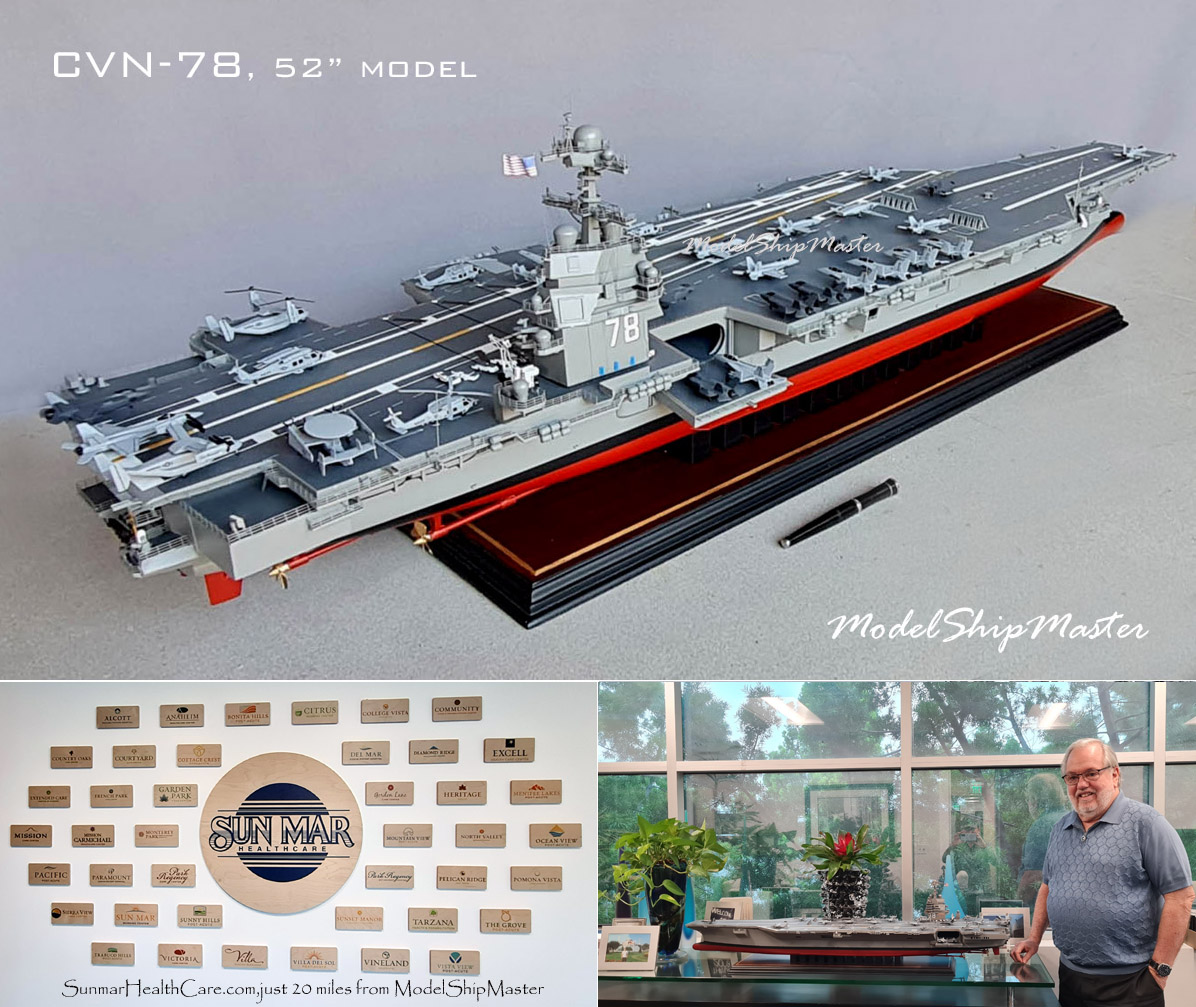
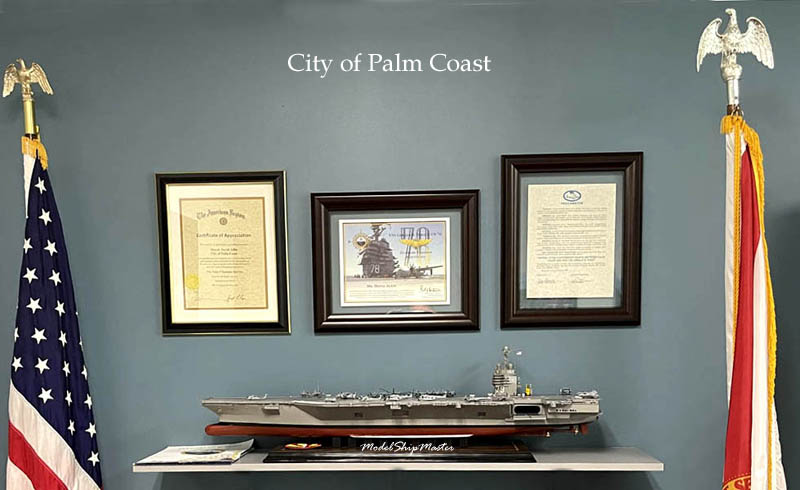 |
Not all Gerald Ford
aircraft carrier models are the same. They might
look good from afar but linger a bit more and you will
notice important differences. Our model's hull, for
example, has correct shape and waterline. Our model's
island is the most accurate by a wide margin. The mast's radars and
other features are unmatched. On the deck, you can see
correct markings, a drone, Osprey aircraft, and F-35s. ModelShipMaster is the very first company that
introduced the Joint Strike Fighter F-35c to aircraft
carrier models, on April, 5, 2021.
We also pioneered the tanker drone MQ-25
Stingray which had been approved by the US Navy but not
employed on US ships yet (as of early 2021.) Sure other companies eventually will copy those
(as of 12/2024, none has so done) but there are
many features much more difficult
for them to spot and copy.
When you compare models,
always remember to look for large
photos that show small sections of the ship. It's a
world of difference.
|
"I was
hoping you could help us with the request. Although I
cannot elaborate further at this time, these models will
be going to individuals that have been instrumental in
the design and operations of the ship.
With their intimacy of the ship,
there is no other vendor that we would feel comfortable
using. Please let me know (i) if this is
possible, (ii) the price per unit, and (iii) the
approximate turnaround time. We really appreciate your
help, and I hope we have the opportunity to work
together on this. Best, H. O'Neil"
Learn more about the
USS Gerald Ford here:
https://en.wikipedia.org/wiki/Gerald_R._Ford-class_aircraft_carrier
|